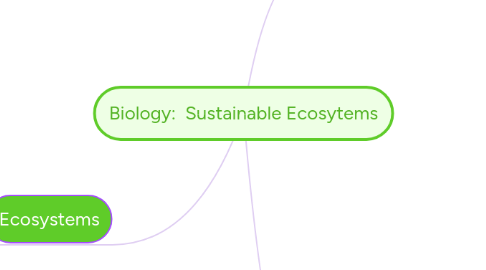
1. Ecosystems
1.1. biomes and the biosphere
1.1.1. biome
1.1.1.1. a large geographical region that contains similar ecosystems
1.1.2. freshwater biome
1.1.2.1. a water biome with very little salt content
1.1.3. marine biome
1.1.3.1. a water biome with high salt content
1.1.4. terrestrial biome
1.1.4.1. a biome that is on land
1.1.5. aquatic biome
1.1.5.1. a biome that is in water
1.1.6. hydrosphere
1.1.6.1. is made up of all the water on Earth
1.1.7. lithosphere
1.1.7.1. includes Earth's outer crust and upper mantle, which includes soil
1.1.8. atmosphere
1.1.9. is the layer of gases that surround the Earth
1.2. nutrient cycles
1.2.1. nutrients
1.2.1.1. substances that an organism uses to build and repair the cells of its body
1.2.2. nutrient cycle
1.2.2.1. the process of moving a nutrient back and forth through different mediums
1.2.3. carbon cycle
1.2.3.1. the process in which carbon is recycled
1.2.4. water cycle
1.2.4.1. the process in which water is recycled
1.2.5. nitrogen cycle
1.2.5.1. the process in which nitrogen is recycled
1.2.5.1.1. nitrogen-fixing bacteria
1.2.5.1.2. nitrifying bacteria
1.2.5.1.3. denitrifying bacteria
1.3. food chain and food webs
1.3.1. consumers
1.3.1.1. need to eat other organisms to obtain energy
1.3.1.1.1. primary consumers
1.3.1.1.2. secondary consumers
1.3.1.1.3. tertiary consumers
1.3.2. energy pyramids
1.3.2.1. show the amount of available energy that producers and consumers contain as energy flows from one organism to the next
1.3.2.1.1. 60% of energy disposed through waste
1.3.2.1.2. 30% used to run cellular processes
1.3.2.1.3. 10% used to build up body tissues
1.3.3. producers
1.3.3.1. can carry out photosynthesis and can produce their own chemical energy
1.4. photosynthesis/cellular respiration
1.4.1. cellular respiration
1.4.1.1. glucose+oxygen gas=carbon dioxide gas+water+energy
1.4.2. photosynthesis
1.4.2.1. carbon dioxide gas+ water+sublight=glucose+oxygen gas
1.5. elements of an ecosystem
1.5.1. ecosystem
1.5.1.1. a complex, self-regulating system in which living things interact with each other and with non-living things
1.5.2. sustainability
1.5.2.1. a way of living that ensures that populations of plants, animals and other organisms can continue to interact and reproduce in an ecosystem
1.5.3. stewardship
1.5.3.1. a way of acting that involves taking personal responsibility for the management and care of something (such as, the environment or an ecosystem)
1.5.4. niche
1.5.4.1. all interactions of a given species with the ecosystem
1.5.5. biodiversity
1.5.5.1. the amount of different species in an ecosystem or area
1.5.6. ecology
1.5.6.1. the study of how organisms interact as with each other and the environment/the study of ecosystems
1.5.7. species
1.5.7.1. a group of similar organisms in an ecosystem
1.5.8. population
1.5.8.1. a group of the same species living in the same area of an ecosystem
1.5.9. habitat
1.5.9.1. the physical environment of an organism
1.5.10. community
1.5.10.1. is made up of many different populations within an area of an ecosystem
1.5.11. abiotic
1.5.11.1. a non-living component of and ecosystem
1.5.12. biotic
1.5.12.1. a living component of an ecosystem
2. Interactions in Ecosystems
2.1. biotic interactions
2.1.1. competition
2.1.1.1. the interaction between two or more organisms competing for the same resources in a habitat
2.1.2. predation
2.1.2.1. when one organism eats another organism to obtain food
2.1.3. symbiosis
2.1.3.1. a close interaction between two different species in which members of one species live in, on, or near members of another species
2.1.3.1.1. mutalism
2.1.3.1.2. commensalism
2.1.3.1.3. parasitism
2.2. population growth
2.2.1. population growth
2.2.1.1. J-curve
2.2.1.1.1. few to no limiting factors, population starts slowly then increases rapidly
2.2.1.2. boom and bust
2.2.1.2.1. sudden increase then sudden decrease, limiting factors or seasonal
2.2.1.3. S-curve
2.2.1.3.1. limiting factor - carrying capacity, starts slowly then increases faster and eventually plateaus
2.2.2. limiting factors
2.2.2.1. an environmental factor that prevents an increase in the number of organisms in a population or prevents them from moving into new habitats
3. The Effects of Human Activity on Ecosystems
3.1. impacts on biodiversity
3.1.1. extinction
3.1.1.1. the death of every member of a certain species
3.1.2. habitat change
3.1.2.1. the process by which humans alter an habitat enough so the native species can no longer live there
3.1.3. native species
3.1.3.1. species that naturally live in a certain habitat/ecosystem
3.1.4. habitat fagmentation
3.1.4.1. when there are patches of altered and original/natural habitats in an ecosystem
3.1.5. overexploitation
3.1.5.1. using a resource faster than it can be replenished
3.1.6. pollution
3.1.6.1. any substance added to the environment that produces a condition that is harmful to organisms
3.1.7. point source pollution
3.1.7.1. pollution that enters a body of water at a specific place from an identifiable source
3.1.8. non-point source pollution
3.1.8.1. pollution that enters a body of water indirectly when water from rain or snow that travels over land and picks up pollutants from many different sources before entering a lake or stream
3.1.9. invasive species
3.1.9.1. a non-native species that causes harm to the ecosystem into which it has been introduced
3.1.10. climate change
3.1.10.1. the climate changing in a region
3.1.11. global warming
3.1.11.1. an increase in the Earth's average temperature caused partly due to the amount of carbon dioxide in the air/atmosphere
3.2. impacts on Ontario ecosystems
3.2.1. urban sprawl
3.2.1.1. the unplanned, disorganized growth of urban and suburban development into the surrounding countryside
3.2.2. clearcutting
3.2.2.1. a method of logging that removes all the trees in an area at one time, regardless of the size
3.3. bioaccumulation and biomagnification
3.3.1. bioaccumulation
3.3.1.1. the gradual build up of a substance in an organism's body
3.3.2. biomagnification
3.3.2.1. when a substance that bioaccumulated becomes more concentrated in each link of a food chain as one animal eats many contaminated organisms

